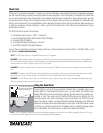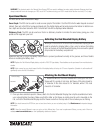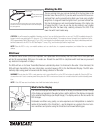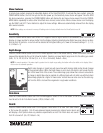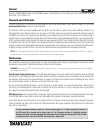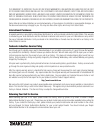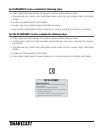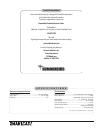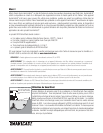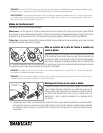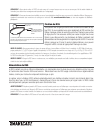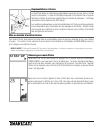
Attaching the RSS
The line coming from your reel can be tied off to the front hole in the
Remote Sonar Sensor (RSS). If you also wish to use the RSS as a con-
ventional float, use the second hole to attach your hook using a lighter
weight line. A snag will break the lighter line if you have to break free.
Slip line techniques are not recommended because of the higher risk
of losing the RSS. If you do use the slip line method, use a lighter
weight line after the lower stop, enabling retrieval of the RSS if the
lower line with hook breaks away.
CAUTION: You will increase the possibility of breaking your line if you use light test pound line on your reel. The RSS is positively buoyant (is
buoyant under its own weight plus 0.2 ounces or 5.7 g of bait and lead weight.) The maximum amount of weight for any attachment to the
RSS is approximately
¹
²₆₄
to
¹³₆₄
ounces (5.3 g to 5.8 g), and includes the combined weight of any hook, line, weight, swivel/snap swivel and
bait that is attached to the RSS. The RSS itself weighs 1 ounce (28 g), and therefore light test line might break.
NOTE: Store the RSS in a dry, non-metallic container, such as a tackle box, in a separate compartment, and isolated from any metallic
devices.
RSS Power
The Remote Sonar Sensor (RSS) has a separate, non-replaceable lithium battery that has a shelf life of three years and
will last for approximately 400 hours of in-water use. Discard the used RSS in compliance with local laws as you would
any electronic component or battery.
The RSS will turn on its Sonar Transmitter/Receiver automatically when it is immersed in the water. Once immersed, the
RSS will begin transmitting the sonar information via radio frequency (RF) to the Rod Mounted Display. The RSS auto-
matically stops using power a few seconds after being pulled out of the water.
WARNING! Do not place the RSS in a wet area when not in use as this will turn on the RSS and shorten its usable life. Store the RSS in a
dry area when not in use to conserve power. Never place the RSS in a wet area of a boat or on a metal surface that could accidentally power
it on.
NOTE: If the RSS was used in salt water, rinse it with fresh water before storing it.
What’s On the Display
The SmartCast displays under-water information in an easy to understand format. The top
of the display corresponds to the water surface, and the bottom of the display corresponds
to the selected Depth Range (see Depth Range). The display varies as the area under the
RSS changes.
Underwater conditions vary greatly, so some experience and interpretation is needed to
realize all the benefits of the SmartCast – use the diagram as a guide to the most com-
mon conditions and practice using the SmartCast over known bottom types.
Present
Depth
Bottom
Fish
Icon
Depth
Range
Use a heavy test line, standard
knots, and tackle such as a
swivel.
Handle the RSS by the antenna tower when it
has been in water.
The second leader hole is for using the RSS as a float. Connect a lighter weight
hook line to this hole. Do not over-weight the hook line as this will submerge the
RSS, causing signal loss.



